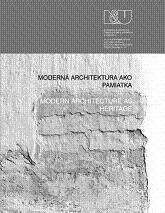OBNOVA MODERNEJ ARCHITEKTÚRY VO VNÍMANÍ DNEŠNÝCH ARCHITEKTOV
MODERN ARCHITECTURE RENEWAL IN PERCEPTION OF CONTEMPORARY ARCHITECTS
Author(s): Katarína AndrášiováSubject(s): Cultural Essay, Political Essay, Societal Essay
Published by: Historický ústav SAV, v. v. i.
Keywords: architect; perception; legacy; modern; preservation; Modernism; restoration; value
Summary/Abstract: In defiance of the unwritten rule that at least half a century needs elapse from the creation of an architectural work for it to assume the status of a protected landmark, many important works of Slovakia’s modern architecture are not protected by law. Opinions, priorities or rules for the protection of modern architecture still remain unfixed in our country, though discussion is well underway among architects, preservationists, researchers and historians. In determining and practically preserving these values, many circumstances and factors collide, often changing in connection with changes in society as a whole. The goal of the present study is to transfer, on the basis of the working approaches of the ‘oral history’ method, some of these aspects and contribute to the formulation of approaches or principles for the protection of modern architecture. Research has focused on ascertaining the views and opinions of currently active architects on the problems of dealing with the modern architectonic legacy; included in the research methods were investigative interviews with architects who in their work have dealt with projects for the restoration of important works of modern architecture. One precondition for the responsible and sensitive handling of the modern architectural legacy is a sufficient degree of awareness, understanding and acceptance. It could be said that interest in the architecture of Modernism remains a continual presence among Slovakia’s architects, as confirmed by the investigative interviews. Largely, this is an interest on the individual and professional levels – an interest in its history or as a source of creative inspiration, yet its intensity fluctuates in connection with the current state of society and the development of its historical awareness. A more permanent renewal of interest in the problematics of architectural Modernism among architects only came about with the decline of Postmodernism – an increased awareness of the historical value of High Modernism and its use as one possible source for seeking out new forms of architectonic expression. Hence it was only from the mid-1980s that modern architecture became the object of targeted protection and preservationist-minded restoration, and when the largest group of Modernist buildings were registered as landmarks. Extensive reconstructions of important works of interwar Modernist architecture began to take place starting in the 1970s, roughly forty years after the buildings had been completed. By this point a number of the buildings were registered landmarks, though many of those reconstructed were not. In particular, two examples in Bratislava – the Savings Bank by Juraj Tvarožek and the Baťa department store by Vladimír Karfík – were followed along with the participating architects in terms of how the approaches to their renewal and maintenance changed with relation to the fall of Communism in 1989 and the transfer of these commercial properties to private hands. B
Journal: Architektúra & Urbanizmus
- Issue Year: 44/2010
- Issue No: 3-4
- Page Range: 294-309
- Page Count: 16
- Language: Slovak

